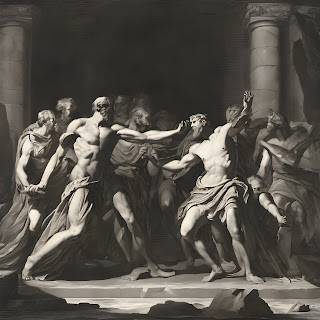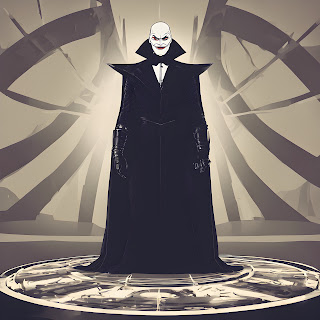The ancient Greek satyrs hold a unique place in both culture and mythology. These fascinating creatures, half-human and half-animal, have captured the imagination of countless generations. In this article, I will explain the origin and evolution of satyrs in Greek mythology, their role in Dionysian revelry and festivals, examine their representation in ancient Greek art and sculpture, and discover their influence on literature, theatre, modern culture, and mythology.
The Origin and Evolution of Satyrs in Greek Mythology
The origins of satyrs can be traced back to ancient Greek mythology. According to mythological accounts, satyrs were companions of Dionysus, the Greek god of wine. They were depicted as wild and lustful creatures with goat-like features such as horns, hooves, and a tail. Satyrs were often portrayed as mischievous and playful, embodying the untamed and primal forces of nature.
As Greek mythology evolved, so did the role of the satyrs. They became associated with fertility, pleasure, and the celebration of life. Satyrs were believed to inhabit forests and mountains, engaging in wild dances and revelries. They were often depicted as followers of Dionysus, participating in his ecstatic rituals and festivals.
The Role of Satyrs in Dionysian Revelry and Festivals
Dionysian revelry was a central aspect of ancient Greek culture, and satyrs played a significant role in these festivities. They were seen as the embodiment of the uninhibited and hedonistic spirit of Dionysus, and their presence added an element of chaos and excitement to the celebrations.
During Dionysian festivals, satyrs would join in raucous processions, singing and dancing alongside Dionysus and his followers. They would often carry thyrsus, a staff topped with a pine cone, which symbolised fertility and the power of nature. The wild and frenzied dances of the satyrs were believed to invoke the presence of the gods and bring about divine blessing.
Satyrs in Ancient Greek Art and Sculpture
The influence of satyrs in ancient Greek art and sculpture is undeniable. These mythical creatures were a popular subject for artists who sought to capture their unique blend of human and animal characteristics. Satyrs were often depicted in various poses, engaging in lively dances, or participating in Dionysian revelry.
One of the most famous representations of satyrs is the statue known as the ''Dancing satyr'' or the ''Faun of Praxiteles.'' This exquisite sculpture, dating back to the 4th century BC, showcases the playful and sensual nature of satyrs. It beautifully captures the fluidity of movement and the dynamic energy that satyrs were believed to possess.
Satyrs also appeared in ancient Greek pottery, where they were depicted in scenes of revelry and mythology. These vibrant and detailed illustrations provide valuable insights into the role of satyrs in ancient Greek culture and their significance as symbols of fertility and pleasure.
Satyrs in Literature and Theatre
The influence of satyrs extends beyond visual art and sculpture. They also played a prominent role in ancient Greek literature and theatre. Satyrs appeared in numerous plays and poems, often serving as comic relief or adding a touch of whimsy to the narrative.
In Greek tragedy, satyrs were portrayed as boisterous and foolish characters, providing a contrast to the more serious and tragic elements of the story. They would engage in witty banter, physical comedy, and outrageous antics, bringing laughter and entertainment to the audience.
Satyrs are also featured in epic poems such as Homer's ''The Odyssey'' and Hesiod's ''Theogony.'' In these works, they were depicted as loyal companions of Dionysus and participants in his adventures. Through their inclusion in literature and theatre, satyrs became beloved figures in Greek cultures, capturing the imagination of audiences for centuries.
The Influence of Satyrs on Modern Culture and Mythology
The legacy of ancient Greek satyrs can be seen in various aspects of modern culture and mythology. Their representation in literature, art, and theatre has left and indelible mark on the collective consciousness.
In contemporary literature, satyrs continue to be a source of inspiration. They often appear in fantasy, novels and stories, embodying the untamed and primal forces of nature. Authors draw upon the rich mythology surrounding satyrs to create complex and compelling characters that resonate with readers.
Satyrs have also made their way into popular culture through films and television. In movies such as ''Percy Jackson and The Olympian: The Lightning Thief, '' satyrs are depicted as loyal and courageous companions to the protagonist, bridging the gap between ancient mythology and the modern world.
Famous Satyr Characters in Literature and Film
Several famous satyr characters have emerged in literature and film, further cementing the enduring legacy of these mythical creatures. One of the most well-known satyr characters is Mr. Tumnus from C.S Lewis's ''The Chronicles of Narnia'' series. Mr. Tumnus is a kind-hearted and musical satyr who befriends the main characters and aids them on their journey.
Another notable satyr character is Grover Underwood from Rick Riordan's ''Percy Jackson and the Olympians'' series. Grover is a satyr who serves as Percy Jackson's best friend and protector. His humorous and loyal nature has endeared him to readers and viewers alike.
Misconceptions and Stereotypes About Satyrs
Despite their rich mythology and cultural significance, satyrs have often been subject to misconceptions and stereotypes. These misinterpretations have led to a distorted understanding of these fascinating creatures.
One common misconception is that satyrs are solely lustful and hedonistic beings. While it is true that they were associated with Dionysian revelry and pleasure, satyrs also possessed other qualities. They were often depicted as playful, mischievous, and even wise, embodying a complex range of characteristics beyond their wild and sensual nature.
Exploring Symbolism and Meaning Behind Satyrs
The symbolism and meaning behind satyrs are multi-faceted, reflecting the complexities of human nature and the natural world. Satyrs represent the primal and untamed forces of nature, symbolising the wild and instinctual aspects of humanity.
They also embody the concept of duality, with their half-human, half-animal form representing the delicate balance between civilization and the untamed wilderness. Satyrs remind us of the importance of embracing our wild and instinctual selves while also recognising the need for restraint and self-control.
Conclusion
From the origins in Greek mythology to their representation in ancient art, literature, and theatre, satyrs have left an indelible mark on culture and mythology. Their playful mischievous nature, their association with Dionysian revelry, and their unique blend of human and animal characteristics continue to captivate the imagination.
Despite misconceptions and stereotypes, satyrs remain powerful symbols of the untamed and primal forces within us all. Their enduring legacy serves as a reminder of the rich tapestry of ancient Greek culture and the enduring power of myth and storytelling.
If you find this article insightful, please consider sharing it on your social media by clicking the social media icons below. Your support is appreciated!
Relevant Articles
References
YouTube
















